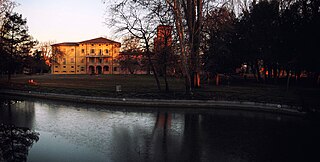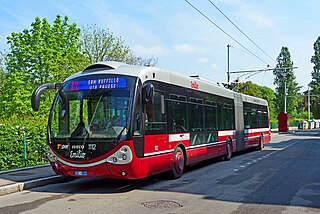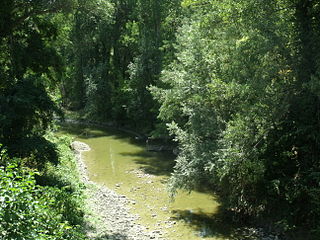
The Saône is a river of eastern France. It is a right tributary of the Rhône, rising at Vioménil in the Vosges department and joining the Rhône in Lyon, just south of the Presqu'île.

The province of Bologna was a province in the Emilia-Romagna region of Italy. Its provincial capital was the city of Bologna. The province of Bologna covered an area of 3,702.32 square kilometres (1,429.47 sq mi) and had a total population of 1,004,323 inhabitants as of 31 December 2014, giving it a population density of 271.27 inhabitants per square kilometre. It was replaced by the Metropolitan City of Bologna starting from January 2015.

Casalecchio di Reno is a town and comune in the Metropolitan City of Bologna, Emilia-Romagna, northern Italy.

San Lazzaro di Savena is an Italian comune (municipality) of some 32,000 inhabitants in the Metropolitan City of Bologna, Emilia-Romagna.
The Battle of Zappolino, the only battle of the War of the Oaken Bucket, was fought in November 1325 between forces representing the Italian towns of Bologna and Modena, an incident in the series of raids and reprisals between the two cities that were part of the larger conflicts of Guelphs and Ghibellines. The Modenese were victorious. Though many clashes between Guelphs and Ghibellines loomed larger to contemporaries than to historians, the unusually-large encounter involved 4000 estimated cavalry and some 35,000 foot soldiers, and 2000 men lost their lives. The location of the battle, at the foot of a hill just outside the castle walls, is now a frazione of the municipality of Castello di Serravalle, Emilia-Romagna.

Castel Maggiore is an Italian comune in the Metropolitan City of Bologna, Emilia-Romagna, central Italy, located 9 kilometres (6 mi) north of the centre of Bologna. Though its name recalls a translation like Great Castle, the name is actually derived from the earlier name Castaniolo Maggiore, which means "Bigger Chestnut Tree", in relation to another nearby village still today named "Castagnolino", meaning "Small Chestnut Tree".

Bentivoglio is a comune (municipality) in the Metropolitan City of Bologna in the Italian region of Emilia-Romagna, located about 15 kilometres (9 mi) northeast of Bologna.

Galliera is a comune (municipality) in the Metropolitan City of Bologna in the Italian region Emilia-Romagna, located about 30 kilometres (19 mi) north of Bologna.

Molinella is a comune (municipality) part of Metropolitan City of Bologna in the Italian region Emilia-Romagna, located about 30 kilometres (19 mi) northeast of Bologna.

The Reno is a river of Emilia-Romagna, northern Italy. It is the tenth longest river in Italy and the most important of the region apart from the Po.

The Bologna trolleybus system is part of the public transport network of the city and comune of Bologna, in the region of Emilia-Romagna, northern Italy. While being in operation since 1991, the current system comprises five urban routes: 13, 14, 15, 32 and 33. Additional routes are presently under construction.
Santa Maria Lacrimosa degli Alemanni is a small church and sanctuary, built during the Renaissance era, and located on Via Mazzini number 65 in central Bologna, Italy.

The Palazzo Fantuzzi is a monumental Renaissance style palace located on Via San Vitale number 23 in central Bologna, region of Emilia-Romagna, Italy. The palace is also known as the Palazzo degli Elefanti for its sculpted decoration, and it stands near the church of Santi Vitale e Agricola.

The Savena is a river in the Tuscany and Emilia-Romagna regions of Italy. The source of the river is in the province of Florence west of Firenzuola in the Appennino Tosco-Emiliano mountains. The river flows north into the province of Bologna and flows near Monghidoro, Loiano, Pianoro and San Lazzaro di Savena before curving east and flowing into the Idice east of Bologna.
Santa Maria della Neve is a now-deconsecrated, former Roman-Catholic church, located in Vicolo della Neve #5 in Bologna, region of Emilia Romagna, Italy.
Officine Maccaferri SpA (Maccaferri) is an Italian, family-owned multinational company. The company is specialised in products for the construction industry. It is 100% owned by the Maccaferri family and has headquarters in Zola Predosa, Metropolitan City of Bologna, Italy. Maccaferri's products are used for: retaining structures, soil reinforcement, embankment stabilisation, river and canal hydraulic works, coastal protection, erosion control, rockfall mitigation, debris flows and avalanche protection. The company provides technical support to designers, contractors and end-users.
The following is a timeline of the history of the city of Ravenna in the Emilia-Romagna region of Italy.
The Bologna tramway network was an important part of the public transport network of Bologna, Italy. It was established in 1880 and discontinued in 1963.
The Teatro Contavalli was an opera house and theatre located at Via Mentana #2, in Bologna, region of Emilia-Romagna, Italy. Long since utilized as a theater, the site is now occupied by offices for the Centro Italiano di Documentazione sulla Cooperazione e L' Economia Sociale.
Trasporto Passeggeri Emilia-Romagna is a public company overseeing public transportation in the Metropolitan City of Bologna, in the province of Ferrara and in parts of the provinces of Modena and Ravenna, Italy.












